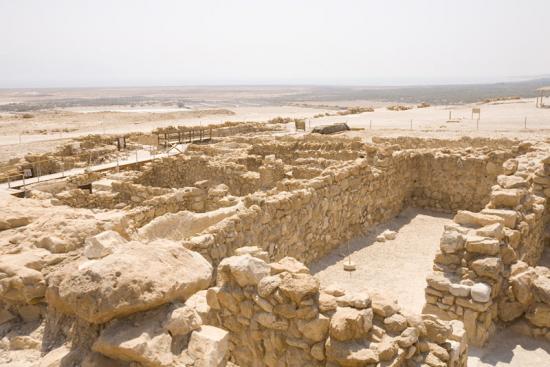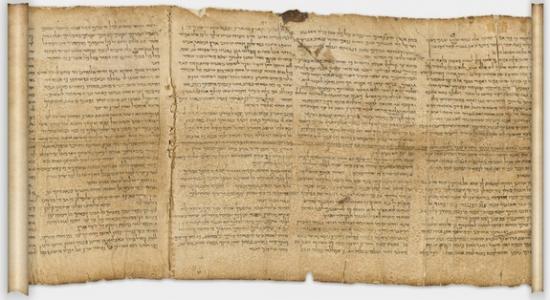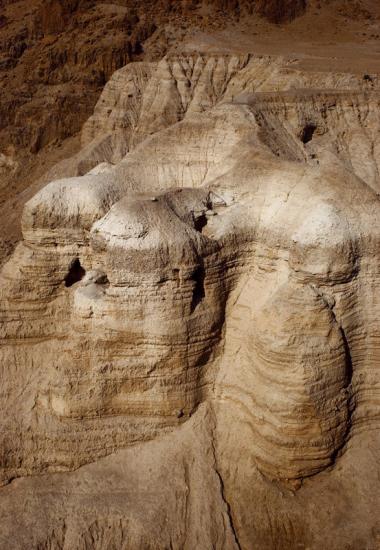Mystery of Dead Sea Scroll Authors Possibly Solved
Owen Jarus
Source -http://www.livescience.com/17123-dead-sea-scrolls-writers-textiles.html

First excavated by Roland de Vaux in the 1950s, the site of Qumran in Israel is mired in controversy. De Vaux believed that it was a monastic settlement used by the Essenes and that the Dead Sea Scrolls were composed here. More recent archaeological work has cast doubt on this idea. The new textile research may help resolve the debate. CREDIT: Joseph Calev | | Shutterstock
The Dead Sea Scrolls may have been written, at least in part, by a sectarian group called the Essenes, according to nearly 200 textiles discovered in caves at Qumran, in the West Bank, where the religious texts had been stored.
Scholars are divided about who authored the Dead Sea Scrolls and how the texts got to Qumran, and so the new finding could help clear up this long-standing mystery.

The Great Isaiah Scroll is one of the original seven Dead Sea Scrolls discovered in Qumran in 1947. It is the best preserved of the scrolls, and is nearly complete. Credit: The Israel Museum, Jerusalem
The research reveals that all the textiles were made of linen, rather than wool, which was the preferred textile used in ancient Israel. Also they lack decoration, some actually being bleached white, even though fabrics from the period often have vivid colours. Altogether, researchers say these finds suggest that the Essenes, an ancient Jewish sect, "penned" some of the scrolls.
Not everyone agrees with this interpretation. An archaeologist who has excavated at Qumran told LiveScience that the linen could have come from people fleeing the Roman army after the fall of Jerusalem in A.D. 70, and that they are in fact responsible for putting the scrolls into caves.
Iconic scrolls
The Dead Sea Scrolls consist of nearly 900 texts, the first batch of which were discovered by a Bedouin shepherd in 1947. They date from before A.D. 70, and some may go back to as early as the third century B.C. The scrolls contain a wide variety of writings including early copies of the Hebrew Bible, along with hymns, calendars and psalms, among other works. Nearly 200 textiles were found in the same caves, along with a few examples from Qumran, the archaeological site close to the caves where the scrolls were hidden.

In 1947 a Bedouin shepherd unearthed the first of nearly 900 texts that would come to be known as the Dead Sea Scrolls. They were found in a series of 11 caves near Qumran, Israel Credit: Dejan Gileski | Shutterstock
Orit Shamir, curator of organic materials at the Israel Antiquities Authority, and Naama Sukenik, a graduate student at Bar-Ilan University, compared the white-linen textiles found in the11 caves to examples found elsewhere in ancient Israel, publishing their results in the most recent issue of the journal Dead Sea Discoveries.
A breakthrough in studying these remains was made in 2007 when a team of archaeologists was able to ascertain that colorful wool textiles found at a site to the south of Qumran, known as the Christmas Cave, were not related to the inhabitants of the site. This meant that Shamir and Sukenik were able to focus on the 200 textiles found in the Dead Sea Scroll caves and at Qumran itself, knowing that these are the only surviving textiles related to the scrolls.
They discovered that every single one of these textiles was made of linen, even though wool was the most popular fabric at the time in Israel. They also found that most of the textiles would have originally been used as clothing, later being cut apart and re-used for other purposes such as bandages and for packing the scrolls into jars.
Some of the textiles were bleached white and most of them lacked decoration, even though decoration is commonly seen in textiles from other sites in ancient Israel.
According to the researchers the finds suggest that the residents of Qumran dressed simply.
"They wanted to be different than the Roman world," Shamir told LiveScience in a telephone interview. "They were very humble, they didn't want to wear colorful textiles, they wanted to use very simple textiles."
The owners of the clothing likely were not poor, as only one of the textiles had a patch on it."This is very, very, important," Shamir said. "Patching is connected with [the] economic situation of the site."
Shamir pointed out that textiles found at sites where people were under stress, such as at the Cave of Letters, which was used in a revolt against the Romans, were often patched. On the other hand "if the site is in a very good economic situation, if it is a very rich site, the textiles will not be patched," she said. With Qumran, "I think [economically] they were in the middle, but I'm sure they were not poor."
Robert Cargill, a professor at the University of Iowa, has written extensively about Qumran and has developed a virtual model of it. He said that archaeological evidence from the site, including coins and glassware, also suggests the inhabitants were not poor.
"Far from being poor monastics, I think there was wealth at Qumran, at least some form of wealth," Cargill said, arguing that trade was important at the site. "I think they made their own pottery and sold some of it, I think they bred animals and sold them, I think they made honey and sold it."
PART. 2